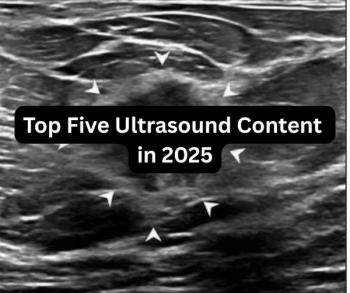
Elastography undergoes review for prostate cancer detection
Elastography is attracting growing attention in prostate imaging. The term refers to the measurement of the elastic properties of tissues, based on the well-established principle that malignant tissue is harder than benign tissue. A color classification system registers tissue as benign (green) or malignant (blue).
Elastography is attracting growing attention in prostate imaging. The term refers to the measurement of the elastic properties of tissues, based on the well-established principle that malignant tissue is harder than benign tissue. A color classification system registers tissue as benign (green) or malignant (blue).
A raw ultrasound is obtained before and after a slight compression of tissue, typically achieved with an ultrasound transducer. Elastography measures and displays strain, or the change in the dimension of tissue elements at various locations in the region of interest.
Dr. Ethan Halpern, a professor of radiology and urology at Thomas Jefferson University in Philadelphia, Pennsylvania, performed a trial of 137 patients, in which targeted biopsy with Doppler and elastography improved prostate cancer detection but missed a substantial minority of cancers found on systematic sextant biopsy.
"Success depends on applying pressure evenly to prostate, and that is difficult to achieve with current systems," Halpern said.
Researchers in Austria have been working to overcome the technique's limitations. To make compression easier, for example, they use a narrower region of interest, examining the right, middle, and left parts of the prostate. This technique significantly improves overall accuracy but is much more time consuming, said Dr. Ferdinand Frauscher, director of uroradiology at the Medical University Innsbruck. Frauscher shared his experience with elastography at the 2006 European Congress of Radiology.
A software technique that assigns elasticity coefficient values for the stiffness of tissues, in addition to the color values, is also proving useful. The coefficient values offer a more objective measure of malignancy than do the colors, Frauscher said.
Results of a new unpublished study of elastography in 100 patients are encouraging. Radiologists obtained elastography images and performed a targeted biopsy if an abnormality was detected. They found cancer in 36 of 100 (36%) patients with a mean PSA of 4.1. Results were compared with systematic biopsy. Elastography detected cancer in 29 subjects, and systematic biopsy found cancer in 26 subjects. Elastography had a sensitivity of 81% and specificity of 84%.
"The results are better than expected," Frauscher said.
Some cancers are still missed, however, such as those located in the anterior prostate and small masses. Frauscher noted that his results may not apply across the board, because he is working with a screening population. Patients in prostate screening programs tend to be younger with smaller glands, which are easier to examine with elastography. The technique is performed only in first biopsies, where it may be more effective.
Frauscher and Halpern agree that in coming years radiologists will play a greater role in prostate imaging, because techniques like contrast-enhanced ultrasound and elastography require a higher skill level. Ultrasound is the workhorse for prostate imaging, although interesting work is under way with high-field MR and MR spectroscopy imaging.
Newsletter
Stay at the forefront of radiology with the Diagnostic Imaging newsletter, delivering the latest news, clinical insights, and imaging advancements for today’s radiologists.


























